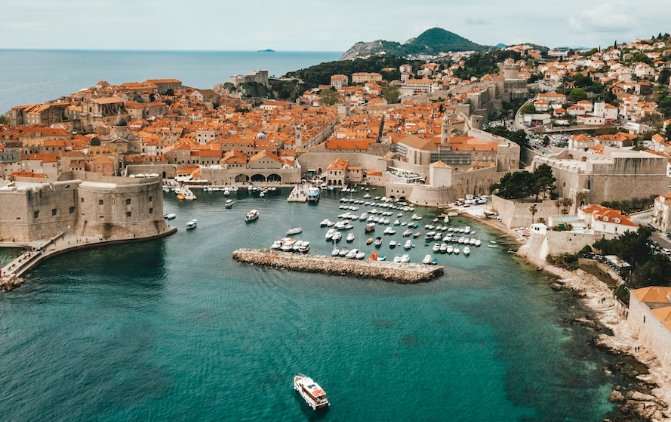Palermo: A Guide to Vibrant Activities

Recommended Activities in Elephant Island, Thailand
August 6, 2025
The 7 Best Rustic Cabin Vacations in Texas
August 10, 2025Palermo is quite possibly the most underrated city in Italy. This is not for the faint of heart, but it is really swaggering. Sexy, scruffy and a little addictive, Palermo rewards travelers who take the time to get to know it. Slender alleys stretch to crumbling squares lined with palaces and terracotta-colored landmarks dot Palermo’s low-rise skyline.
Cultures from the Middle East, Europe and Africa influence everything from food to architecture to dialects. At a glance it is clear who came and conquered the buildings: Phoenicians, Normans, Turks, Egyptians, Arabs and Spaniards. All life is concentrated in Italy’s most ethnically diverse city. Here’s how to best experience it.

Best Thing to Do
Computer culture
Even if you’re not a nerd, you’ll find MEC (Meet, Eat, Connect) to be a fun way to pass an hour or two. Located inside the 16th-century Palazzo Castrone opposite the Norman Arab Cathedral, the concept of this museum restaurant blends technology and cuisine. Architect Giuseppe Forello owns one of Europe’s largest Apple collections, part of which appears in this exhibition, tracing the company’s history, including a collection of original Macs, iMacs and iPads, as well as Steve Jobs’ sneakers, jeans and watches. Every night except Sundays, Chef Carmelo Trentacosti (who worked at Rocco Forte’s luxurious Villa Igiea hotel) prepares an avant-garde Sicilian-inspired menu that recently earned him a well-deserved Michelin star.
Food for thought
Food walking tours at Culinary Backstreets are the best way to experience the authentic flavors of a place, taste famous (and lesser-known) dishes, and learn interesting facts. Taste Palermo: at the market and elsewhere is their latest tour (£107 for adults); A plug-in local guide will take you to places known only to locals, tasting panzerotti rolls with mozzarella cheese and anchovie filling and fried chickpea flour fritters, a great example of early Arab influence. Elastic waistband and enjoy Sfincione’s thick pizza with focaccia bread, seasoned with sweet onions, oregano and a variety of cheeses, from creamy ricotta to savory Cassio cavallo. There’s also a strong cultural element, with visits to puppet workshops, handmade dolls made of wood and metal for everyday performances, and a fifth-generation carob dessert factory.
Urban art
Multicultural murals throughout the city commemorate immigrants from the past and present. One of the oldest districts of the city, La Kalsa’s historic Arabian quarter is home to residential areas themed around the Federico II tribute, known for inclusion, and the face of a beautiful black woman with her head covered and a golden halo-like design shining in the back.
Near the Bararo market in the Alberria district, a small hummingbird lifts a huge rock with its wings and accomplishes the impossible. Nearby, towering brown-skinned St. Benedict Moorish murals guard residential squares and football fields.

Best Time to Visit
Although Palermo is a year-round destination, late spring and early autumn are the peak seasons because the Mediterranean heat brought by the Sirocco winds is less intense. The low season (November to April) brings lower hotel prices and fewer crowds.
Where to Stay
B&B Sant Agostino
This art-filled B&B is located in a narrow side street near the Teatro Massimo, where the opera is held, close to culture. Located at the top of a 19th-century palace, B&B Sant Agostino has a charming collection of rooms and suites that vary: some with four-poster beds, beams and small windows frame the roof view, while others have two floors with lounges and sofa beds. All rooms have access to a nice, plant-filled terrace and a room with frescoed ceilings, where a homemade breakfast is served every morning. santagostinobb.it
Grand Hotel et des Palmes
The historic Grand Palm Hotel has been brilliantly renovated to this Art Nouveau mansion, which was once home to the Ingham-Whittakers, which sold Marsala wines (and where Wagner wrote his last opera). The sensitive revival and fusion of original features with fresh, modern design creates a charming place on the busy Roman avenue. Hand-painted wallpaper and gilded-rimmed mirrors blend in with burgundy velvet sofas and honey-colored oak floors. Start your day in the glass-roofed winter garden with Sicilian specialties such as creamy sweet stuffed pancake rolls (cream-filled horns). Grand Palm Hotel .com
Villa Igiea
Located on the Bay of Palermo, this Belle Époque-style palace-turned-Rocco Forte resort contrasts with the hustle and bustle of the city. You’ll find quirky towers, a terrace garden with fragrant citrus, lemon and olive trees, a curved pool and a suite designed by Olga Polizzi with terracotta brick terraces facing the sea. Original murals, antique doors and handmade tiles are as impressive as the Sicilian menu made with local ingredients; Add to that a smile service and a scented public space. roccofortehotels.com

Where to Eat
Sicilians love ice cream so much that they eat it for breakfast, adding a spoonful of sweets to the round brioche bread. It’s not hard to find kiosks selling fine creamy jasmine or cinnamon ice cream, but if you’re near the port, try Gelateria Rorò in Piazza Marina, which also offers vegan flavours.
Located on the other side of the port, Piccolo Napoli opened in 1951 as a small neighborhood restaurant with white tablecloths and black and white family photos (including contemporary owners) on the walls. The slightly unpopular terrace offers simple Sicilian dishes, from hot sesame bread sprinkled with oregano to fresh tuna steak, pasta with cuttlefish sauce, and sweet and savory combinations of eggplant, basil, celery and capers. The tomatoes that make up the classic Caponata.
Does anyone have spleen sandwiches? Located on the corner of Via Vittorio Emanuele Street and the banyan tree-lined Piazza Marina, the Nni Franco U Vastiddaru restaurant is packed with locals who are enjoying the aforementioned lemon and salt-boiled beef offal, or ricotta and Cascio cavallo. If not, order arancini, a fried risotto ball filled with a delicious mixture of bolognese, green beans, and mozzarella.
The rose-filled gardens of Santa Caterina Monastery are the perfect place to experience God-given Sicilian desserts such as Casata (sweet cotta cheese sponge cake). I Segreti del Chiostro pastry shop uses once secret recipes to help Dominican nuns living in apartments overlooking the courtyard earn an income.
Where to Drink
Deca Bistro’s bartender quickly and elegantly concocts colorful cocktails amidst white walls and industrial-style seating. On warm evenings, sit on the terrace that occupies a large part of Piazza Giovanni Melly. Sip a cool, colourful Sprite next to the huge Baroque church of San Domenico, where the eponymous poet Giovanni Melly is buried.
Sicampagna is a fine cake shop in Via Riccardo Wagner, with a range of photogenic fruit and macaron celebratory cakes downstairs and a café upstairs decorated in marble, white and Barbie pink. Sip on a bitter espresso to soften the sweetness of Tortasetteveli, a rich, richly flavored chocolate and hazelnut cake usually eaten on birthdays.
Circi is a kiosk and café next to Piazza Beati Paoli with chairs and tables where you can rest your tired feet with a glass of classic Palermitan acqua e zammù (water and star anise spirits). It is used as a digestive drink or a refreshing drink and becomes cloudy if stirred.

Where to Shop
The market in Palermo is full of life. Vucciria is the most famous and popular place for tourists – at night it is like a street party. Ballarò is the largest and most attractive place for the Ballemit people to shop. Capo stretches into the labyrinthine streets of Albergheria and the Capo neighborhood and is rich in fresh fish. Everything is noisy, accompanied by shouting sellers begging you to buy their nocherala olives, pistachios or freshly squeezed juice; The radio was loud, people were singing, a man stood in front of an audience filmed with an iPhone peeling shrimp, and the air filled with everything from fresh fish to sweet dried oregano.
Citrus trees brought to Sicily by North African Muslims in the eleventh century thrive in fertile volcanic soils. The Bay of Palermo was once known as the “Conca d’Oro” (golden shell) for the bright hue and wealth brought by Sicilian lemons, which supply much of Italy. Cassaro Bottega Alimentare, located on Via Vittorio Emanuele, is a small lemon-based shop that sells lemon-shaped soap, pasta and limoncello. A few tables in the backyard are a great place to enjoy an aperitif.
Travel
This compact and compact city is easy to explore on foot, with car-free streets and narrow alleys that you can’t get to by any other way (watch out for motorcycles). AMAT buses run around the city and cost €3.50 (£3) and are valid all day.
Architectural Highlights
On the surface, it’s a mess, with multiple tiered battlements, porches and geometric patterns reflecting the involvement of different builders over the centuries, but the UNESCO World Heritage Site of Palermo Cathedral (Cattedrale di Palermo) is a fascinating place. The end of Via Vittorio Emanuele is a mix of Romanesque, Norman, Gothic, Baroque and Neoclassical styles, impressive by any standard, and the visitor roof terrace is one of the best viewpoints in the city.

Frequently Asked Questions
What currency is needed?
- Euro.
What language do they speak?
- Italian and Sicilian dialects of Palermitano.
Should I tip?
- No tipping is required, but in restaurants you pay between €5 and €20 (to £17) if you want to show your appreciation; If your guide impresses you, pay between €10 and €50 (£8.50 to £43).
What is the time difference?
- GMT +2.
What is the average flight time from the UK?
- Two hours and 50 minutes.
What’s the best view?
- Standing in the heart of the Quattro Canti (Four Corners), you will be in the heart of the old town and reflect its long-lost prosperity. Four roads meet in this ornate Baroque square, surrounded by four towering palaces whose curved facades are decorated with statues of saints and monarchs.
Inside information?
- The grandest and most important celebration of the year is the Feast of Santa Rosalia in July, the patron saint who is said to have saved the city from the plague. The crowded procession and delicious food culminated in the procession of Santa Rosalia’s chariots through the streets.
Is it okay to fly?
- British Airways, Ryanair and easyJet all operate direct flights from the UK. If you prefer to be accompanied while travelling, Kirker Holidays’ full range of tours including flights, hotels, private transfers, activity instructions and destination booking concierge services start at £896 (breakfast included) from opera tickets to a local guide (three nights); kirkerholidays.com)。



